Unit 1 Cultural Heritage Discovering Useful Structures 课件(共30张PPT)-高中英语人教版(2019)必修第二册
文档属性
| 名称 | Unit 1 Cultural Heritage Discovering Useful Structures 课件(共30张PPT)-高中英语人教版(2019)必修第二册 |  | |
| 格式 | pptx | ||
| 文件大小 | 3.8MB | ||
| 资源类型 | 教案 | ||
| 版本资源 | 人教版(2019) | ||
| 科目 | 英语 | ||
| 更新时间 | 2025-05-29 09:31:07 | ||
图片预览


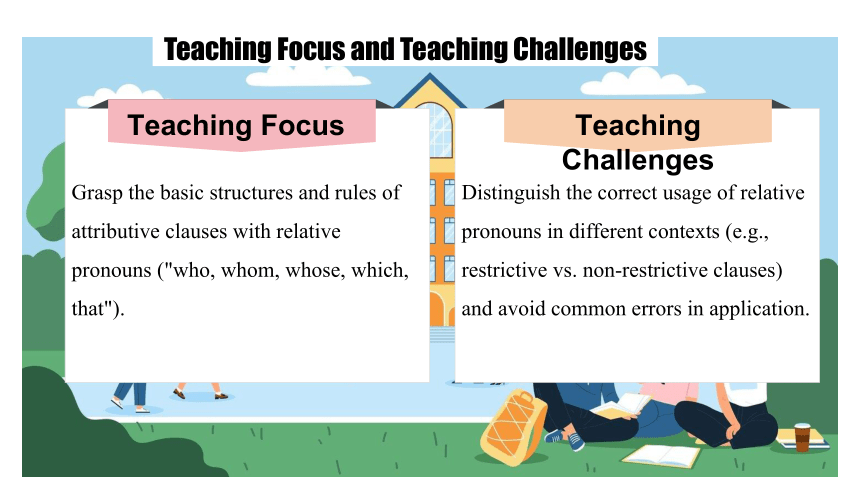
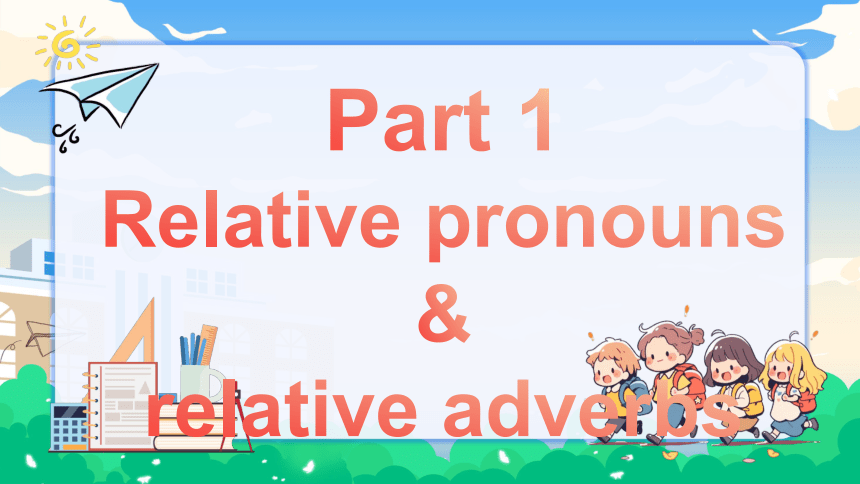

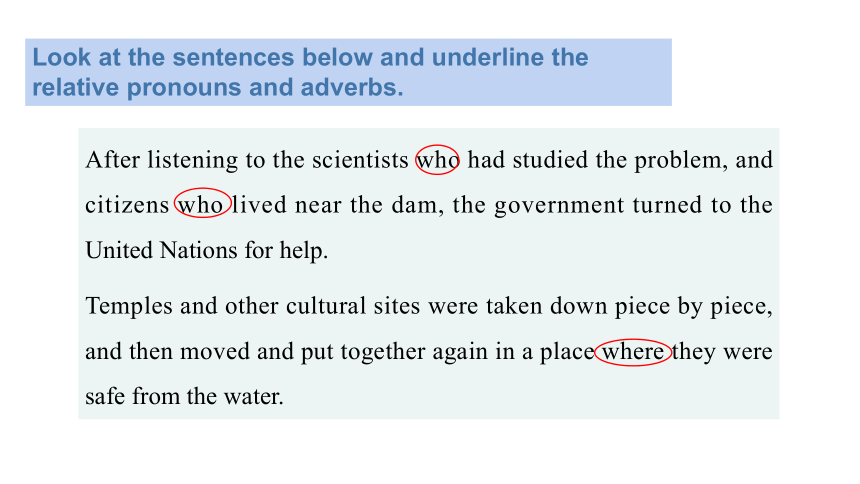
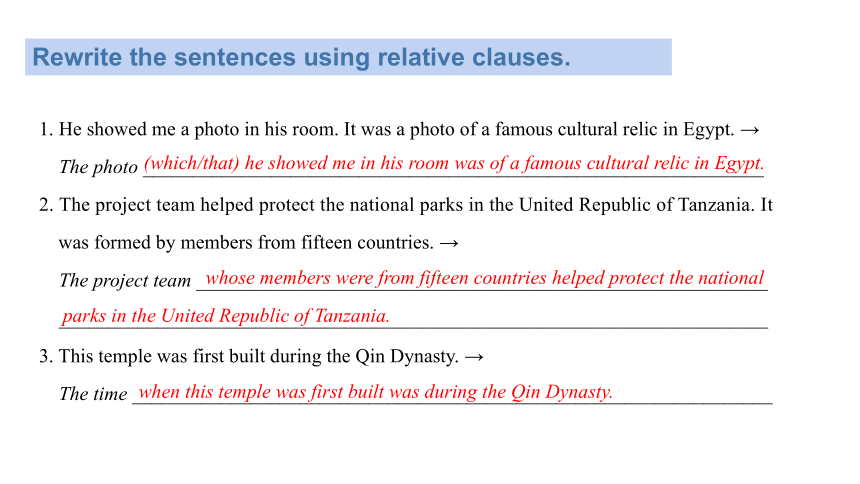
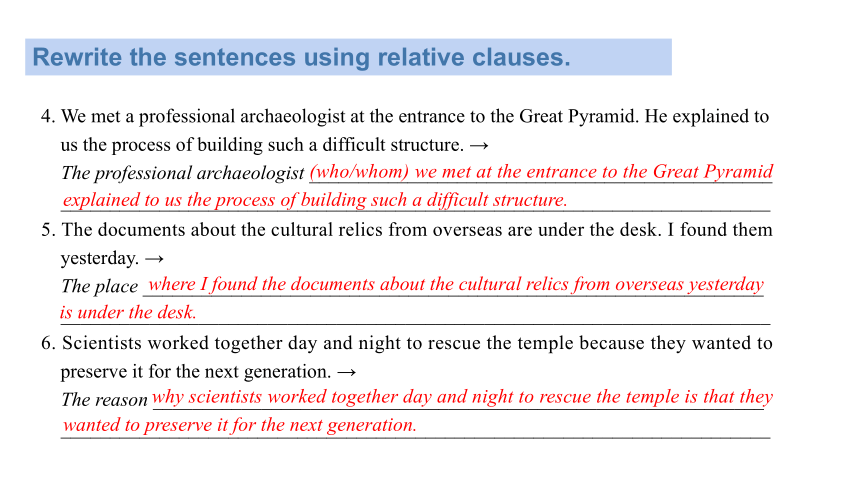
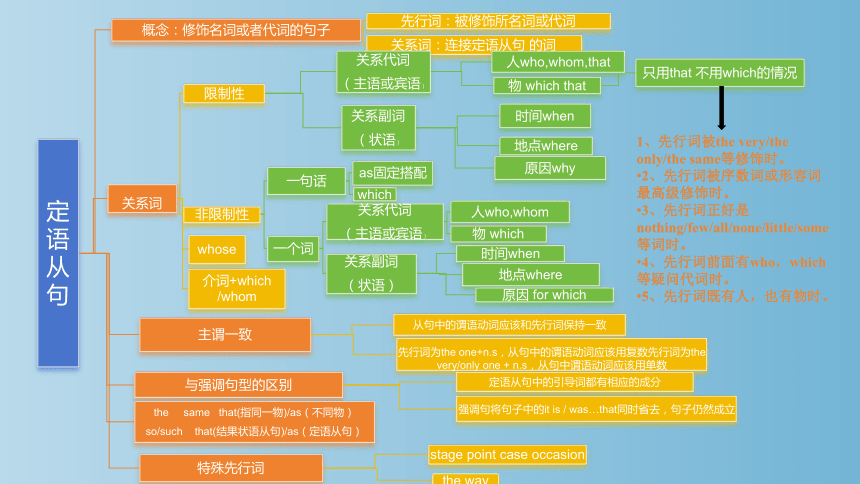

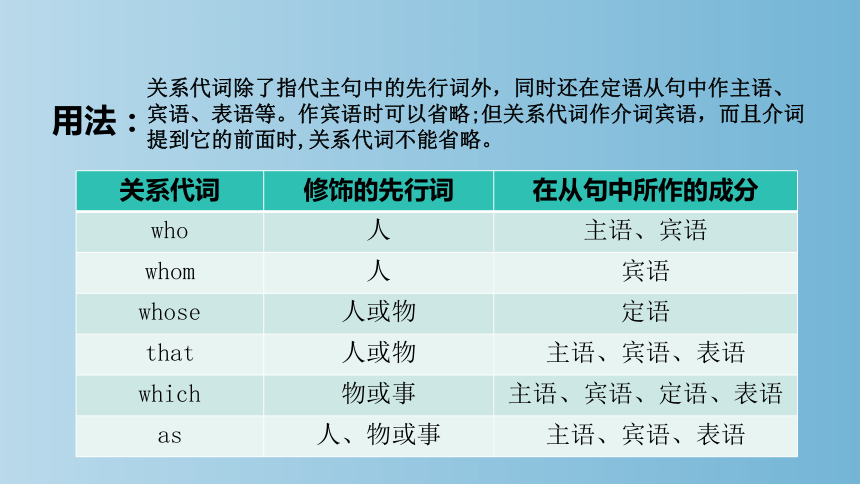
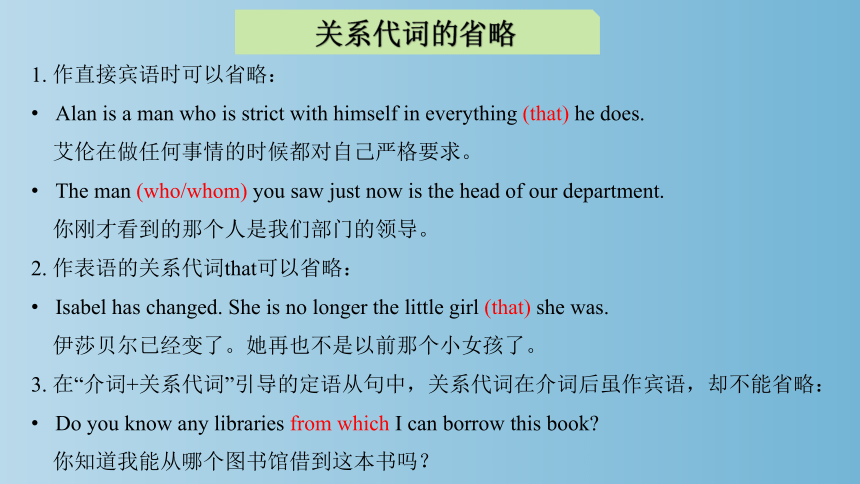
文档简介
(共30张PPT)
Unit 1
Cultural Heritage
Discovering Useful Structures
1
Students can master the usage of attributive clauses introduced by "who, whom, whose, which, that" and understand their functions in sentences.
2
Students are able to correctly apply attributive clauses in writing and oral communication to describe people, things, and their relationships.
Learning Objectives
Teaching Focus
Grasp the basic structures and rules of attributive clauses with relative pronouns ("who, whom, whose, which, that").
Teaching Challenges
Distinguish the correct usage of relative pronouns in different contexts (e.g., restrictive vs. non-restrictive clauses) and avoid common errors in application.
Teaching Focus and Teaching Challenges
Part 1
Relative pronouns &
relative adverbs
One hot summer's day a Fox was strolling
through an orchard till he came to a bunch
of Grapes just ripening on a vine which had been trained over a lofty branch.
Try to translate the following sentence.
一个炎热的夏日,
一只狐狸在果园里
散步,突然他看到高处一根修剪过的葡萄藤上挂着一串刚刚成熟的葡萄。
Lead-in
Look at the sentences below and underline the relative pronouns and adverbs.
After listening to the scientists who had studied the problem, and citizens who lived near the dam, the government turned to the United Nations for help.
Temples and other cultural sites were taken down piece by piece, and then moved and put together again in a place where they were safe from the water.
Rewrite the sentences using relative clauses.
1. He showed me a photo in his room. It was a photo of a famous cultural relic in Egypt. →
The photo _______________________________________________________________
2. The project team helped protect the national parks in the United Republic of Tanzania. It was formed by members from fifteen countries. →
The project team __________________________________________________________
________________________________________________________________________
3. This temple was first built during the Qin Dynasty. →
The time _________________________________________________________________
(which/that) he showed me in his room was of a famous cultural relic in Egypt.
whose members were from fifteen countries helped protect the national parks in the United Republic of Tanzania.
when this temple was first built was during the Qin Dynasty.
Rewrite the sentences using relative clauses.
4. We met a professional archaeologist at the entrance to the Great Pyramid. He explained to us the process of building such a difficult structure. →
The professional archaeologist _______________________________________________
________________________________________________________________________
5. The documents about the cultural relics from overseas are under the desk. I found them yesterday. →
The place _______________________________________________________________
________________________________________________________________________
6. Scientists worked together day and night to rescue the temple because they wanted to preserve it for the next generation. →
The reason ______________________________________________________________
________________________________________________________________________
(who/whom) we met at the entrance to the Great Pyramid explained to us the process of building such a difficult structure.
where I found the documents about the cultural relics from overseas yesterday is under the desk.
why scientists worked together day and night to rescue the temple is that they wanted to preserve it for the next generation.
1、先行词被the very/the only/the same等修饰时。
2、先行词被序数词或形容词最高级修饰时。
3、先行词正好是nothing/few/all/none/little/some等词时。
4、先行词前面有who,which等疑问代词时。
5、先行词既有人,也有物时。
关系副词与关系代词的区别
对比维度 关系代词 关系副词
核心作用 连接主从句并替代先行词 连接主从句,说明从句时间、地点或原因
从句成分 作主语、宾语、定语(如who/whom/which/that/whose) 作时间、地点、原因状语(如when/where/why)
常见先行词 人或物 时间、地点、原因类名词
判断关键 从句缺主宾定→用关系代词(The book (which) I read) 从句主谓宾完整→用关系副词(The day when I arrived)
用法:
关系代词除了指代主句中的先行词外,同时还在定语从句中作主语、宾语、表语等。作宾语时可以省略;但关系代词作介词宾语,而且介词提到它的前面时,关系代词不能省略。
关系代词 修饰的先行词 在从句中所作的成分
who 人 主语、宾语
whom 人 宾语
whose 人或物 定语
that 人或物 主语、宾语、表语
which 物或事 主语、宾语、定语、表语
as 人、物或事 主语、宾语、表语
关系代词的省略
1. 作直接宾语时可以省略:
Alan is a man who is strict with himself in everything (that) he does.
艾伦在做任何事情的时候都对自己严格要求。
The man (who/whom) you saw just now is the head of our department.
你刚才看到的那个人是我们部门的领导。
2. 作表语的关系代词that可以省略:
Isabel has changed. She is no longer the little girl (that) she was.
伊莎贝尔已经变了。她再也不是以前那个小女孩了。
3. 在“介词+关系代词”引导的定语从句中,关系代词在介词后虽作宾语,却不能省略:
Do you know any libraries from which I can borrow this book
你知道我能从哪个图书馆借到这本书吗?
只用that不用which
(1)当先行词是all, little, few, much, everything, nothing, none 等不定代词时。
All that I need is only your advice.
There is not much that ought to be done right now.
Parents always do everything that they can to support their children.
These messages are the very ones that I have been looking for.
(2)当先行词被 all, every, no, little, few, much, the only, the very, the right, the last等修饰时。
只用that不用which
(3) 当先行词是序数词或形容词最高级或被序数词、形容词最高级修饰时。
When it comes to Jinan, the first that comes to mind is the spring water.
That is the best film that has ever been shown so far in the city.
(4)当主句是以which 开头的特殊疑问句时。
Which is one of the things that make people happy
只用that不用which
只用which不用that
(1)关系代词前有介词时。
I'm looking for a box in which I can put all these eggs.
(2)在非限制性定语从句中。
Football, which is a very interesting game, is played all over the world.
(3)先行词为that、those时。
What's that which excites you so much
只用who不用that
先行词是指人的不定代词时,如one,ones,anyone,everyone,everybody,someone等,或先行词为 those且指人时:
The person who bought the house or moved is the one who throws the party.
买了房子或搬家的人是举办派对的人。
Those who dare to break the law will be punished.
那些胆敢违反法律的人将会受到惩罚。
用法:
关系副词在定语从句中充当状语,用于修饰先行词(通常是表示时间、地点或原因的名词),且在从句中不充当主语或宾语。常见的关系副词有 when、where、why。
关系副词 先行词 功能 相当于
when 表示时间的名词,如time、day、occasion 等。 作时间状语
where 表示具体或抽象地点的名词,如place、position、situation、point 等。 作地点状语
why 通常为 reason(s)。 作原因状语
(与关系代词的关系)
地点状语
时间状语
原因状语
介词的选择
1. 依据先行词与从句中动词的搭配来选择
This is the house where I lived last year.
=This is the house in which I lived last year.
2. 依据先行词与从句中名词的搭配来选择
I know the reason why he left.
=I know the reason for which he left.
“live” 常与 “in” 搭配,构成 “live in”
“reason” 常与 “for” 搭配,构成 “for the reason”
介词的选择
3. 依据先行词所表达的含义来选择
This is the city where I was born.
=This is the city in which I was born.
4. 考虑句子所表达的逻辑关系来选择
The year when he graduated from college was 2010.
=The year in which he graduated from college was 2010.
“be born” 通常搭配 “in”,表示 “在某个城市出生”
这里表示 “在某一年”,用 “in” 符合时间上的逻辑关系
介词的选择
5. 表示“所有”或“整体的一部分”时通常用both/none/some/most...+介词 “of ”+which/whom 翻译成:其中两个都,其中没有,其中一个,其中大部分等
He has two sons, _____________ graduated from Peking University.
他有两个儿子,他们都毕业于北京大学。
2) Tom wrote many children’s books, half __________ were about campus culture.
汤姆写了很多儿童书籍,其中一半是关于校园文化的。
both of whom
of which
关系代词or 关系副词?
This is the reason _____________ I didn't come.
why/for which
指时间,地点或原因的先行词在定语从句中作状语时,用关系副词。
指时间,地点或原因的先行词在定语从句中作主语或宾语时,用关系代词。
The reason ___________ she gave was not true.
which/that
判断依据:先行词在从句中所作成分
① 从句缺少主、宾、定
② 从句缺状语
关系代词
关系副词
Part 2
Restrictive &
non-restrictive attributive clauses
限制性定语从句与非限制性定语从句的区别
紧跟在修饰对象(即先行词)之后的定语从句, 先行词和限制性定语从句之间紧密相连,前后相接。
先行词与定语从句没有紧密相连,而是被逗号或其它语句部分隔开。
限制性定语从句
非限制性定语从句
01
限制性定语从句对先行词进行限定,是句子不可或缺的部分,如果省略,句子意思会不完整或不明确。
02
非限制性定语从句对先行词进行补充说明,是句子的附加信息,如果省略,句子意思仍然完整。
限制性与非限制性定语从句的区别
限制性定语从句 非限制性定语从句
与先行词关系密切,删除后影响整个意思的表达 与先行词关系不密切,是一种补充说明,删除后不影响整个意思的表达
不用逗号分开 一般使用逗号分开
可用关系代词that 不可用关系代词that
限制性定语从句 非限制性定语从句
关系代词that,who,which/whom在从句中作宾语时可以省略 关系代词不可以省略
关系代词whom作宾语时可用who或that替代 关系代词不能替代
只可以修饰名词或代词,不可以修饰句子 既可修饰名词或代词,也可以修饰句子,有逗号分开。
Part 3
Exercise
1) The foreign guests, ________ were scientists, were warmly welcomed at the airport.
2) My father bought me several books, none of ________ I like to read.
3) Is there anyone in your class ________ family is in the city
4) Football, ________ is a very interesting game, is played all over the world.
5) The students went to the hospital to see Miss Zhang, _________they respect greatly.
6) They went to the Royal Theatre, ________ they saw the great show.
who
which
whose
which
who/whom
where
用介词 + 关系代词填空。
1. Who is the person _______ _______ you just shook hands
2. China is a powerful country, _______ _______ we are proud.
3. This is the tree _______ _______ we used to play games.
4. This is my glasses, _______ _______ I can’t see clearly.
5. Do you remember the day _______ _______ you joined our club
6. Do you know the reason _____ _______ he lost the job
with whom
without which
under which
of which
on which
for which
Homework
1. Summarise what we have learnt in this lesson;
2. Prepare for the next lesson
See you next time!
Unit 1
Cultural Heritage
Discovering Useful Structures
1
Students can master the usage of attributive clauses introduced by "who, whom, whose, which, that" and understand their functions in sentences.
2
Students are able to correctly apply attributive clauses in writing and oral communication to describe people, things, and their relationships.
Learning Objectives
Teaching Focus
Grasp the basic structures and rules of attributive clauses with relative pronouns ("who, whom, whose, which, that").
Teaching Challenges
Distinguish the correct usage of relative pronouns in different contexts (e.g., restrictive vs. non-restrictive clauses) and avoid common errors in application.
Teaching Focus and Teaching Challenges
Part 1
Relative pronouns &
relative adverbs
One hot summer's day a Fox was strolling
through an orchard till he came to a bunch
of Grapes just ripening on a vine which had been trained over a lofty branch.
Try to translate the following sentence.
一个炎热的夏日,
一只狐狸在果园里
散步,突然他看到高处一根修剪过的葡萄藤上挂着一串刚刚成熟的葡萄。
Lead-in
Look at the sentences below and underline the relative pronouns and adverbs.
After listening to the scientists who had studied the problem, and citizens who lived near the dam, the government turned to the United Nations for help.
Temples and other cultural sites were taken down piece by piece, and then moved and put together again in a place where they were safe from the water.
Rewrite the sentences using relative clauses.
1. He showed me a photo in his room. It was a photo of a famous cultural relic in Egypt. →
The photo _______________________________________________________________
2. The project team helped protect the national parks in the United Republic of Tanzania. It was formed by members from fifteen countries. →
The project team __________________________________________________________
________________________________________________________________________
3. This temple was first built during the Qin Dynasty. →
The time _________________________________________________________________
(which/that) he showed me in his room was of a famous cultural relic in Egypt.
whose members were from fifteen countries helped protect the national parks in the United Republic of Tanzania.
when this temple was first built was during the Qin Dynasty.
Rewrite the sentences using relative clauses.
4. We met a professional archaeologist at the entrance to the Great Pyramid. He explained to us the process of building such a difficult structure. →
The professional archaeologist _______________________________________________
________________________________________________________________________
5. The documents about the cultural relics from overseas are under the desk. I found them yesterday. →
The place _______________________________________________________________
________________________________________________________________________
6. Scientists worked together day and night to rescue the temple because they wanted to preserve it for the next generation. →
The reason ______________________________________________________________
________________________________________________________________________
(who/whom) we met at the entrance to the Great Pyramid explained to us the process of building such a difficult structure.
where I found the documents about the cultural relics from overseas yesterday is under the desk.
why scientists worked together day and night to rescue the temple is that they wanted to preserve it for the next generation.
1、先行词被the very/the only/the same等修饰时。
2、先行词被序数词或形容词最高级修饰时。
3、先行词正好是nothing/few/all/none/little/some等词时。
4、先行词前面有who,which等疑问代词时。
5、先行词既有人,也有物时。
关系副词与关系代词的区别
对比维度 关系代词 关系副词
核心作用 连接主从句并替代先行词 连接主从句,说明从句时间、地点或原因
从句成分 作主语、宾语、定语(如who/whom/which/that/whose) 作时间、地点、原因状语(如when/where/why)
常见先行词 人或物 时间、地点、原因类名词
判断关键 从句缺主宾定→用关系代词(The book (which) I read) 从句主谓宾完整→用关系副词(The day when I arrived)
用法:
关系代词除了指代主句中的先行词外,同时还在定语从句中作主语、宾语、表语等。作宾语时可以省略;但关系代词作介词宾语,而且介词提到它的前面时,关系代词不能省略。
关系代词 修饰的先行词 在从句中所作的成分
who 人 主语、宾语
whom 人 宾语
whose 人或物 定语
that 人或物 主语、宾语、表语
which 物或事 主语、宾语、定语、表语
as 人、物或事 主语、宾语、表语
关系代词的省略
1. 作直接宾语时可以省略:
Alan is a man who is strict with himself in everything (that) he does.
艾伦在做任何事情的时候都对自己严格要求。
The man (who/whom) you saw just now is the head of our department.
你刚才看到的那个人是我们部门的领导。
2. 作表语的关系代词that可以省略:
Isabel has changed. She is no longer the little girl (that) she was.
伊莎贝尔已经变了。她再也不是以前那个小女孩了。
3. 在“介词+关系代词”引导的定语从句中,关系代词在介词后虽作宾语,却不能省略:
Do you know any libraries from which I can borrow this book
你知道我能从哪个图书馆借到这本书吗?
只用that不用which
(1)当先行词是all, little, few, much, everything, nothing, none 等不定代词时。
All that I need is only your advice.
There is not much that ought to be done right now.
Parents always do everything that they can to support their children.
These messages are the very ones that I have been looking for.
(2)当先行词被 all, every, no, little, few, much, the only, the very, the right, the last等修饰时。
只用that不用which
(3) 当先行词是序数词或形容词最高级或被序数词、形容词最高级修饰时。
When it comes to Jinan, the first that comes to mind is the spring water.
That is the best film that has ever been shown so far in the city.
(4)当主句是以which 开头的特殊疑问句时。
Which is one of the things that make people happy
只用that不用which
只用which不用that
(1)关系代词前有介词时。
I'm looking for a box in which I can put all these eggs.
(2)在非限制性定语从句中。
Football, which is a very interesting game, is played all over the world.
(3)先行词为that、those时。
What's that which excites you so much
只用who不用that
先行词是指人的不定代词时,如one,ones,anyone,everyone,everybody,someone等,或先行词为 those且指人时:
The person who bought the house or moved is the one who throws the party.
买了房子或搬家的人是举办派对的人。
Those who dare to break the law will be punished.
那些胆敢违反法律的人将会受到惩罚。
用法:
关系副词在定语从句中充当状语,用于修饰先行词(通常是表示时间、地点或原因的名词),且在从句中不充当主语或宾语。常见的关系副词有 when、where、why。
关系副词 先行词 功能 相当于
when 表示时间的名词,如time、day、occasion 等。 作时间状语
where 表示具体或抽象地点的名词,如place、position、situation、point 等。 作地点状语
why 通常为 reason(s)。 作原因状语
(与关系代词的关系)
地点状语
时间状语
原因状语
介词的选择
1. 依据先行词与从句中动词的搭配来选择
This is the house where I lived last year.
=This is the house in which I lived last year.
2. 依据先行词与从句中名词的搭配来选择
I know the reason why he left.
=I know the reason for which he left.
“live” 常与 “in” 搭配,构成 “live in”
“reason” 常与 “for” 搭配,构成 “for the reason”
介词的选择
3. 依据先行词所表达的含义来选择
This is the city where I was born.
=This is the city in which I was born.
4. 考虑句子所表达的逻辑关系来选择
The year when he graduated from college was 2010.
=The year in which he graduated from college was 2010.
“be born” 通常搭配 “in”,表示 “在某个城市出生”
这里表示 “在某一年”,用 “in” 符合时间上的逻辑关系
介词的选择
5. 表示“所有”或“整体的一部分”时通常用both/none/some/most...+介词 “of ”+which/whom 翻译成:其中两个都,其中没有,其中一个,其中大部分等
He has two sons, _____________ graduated from Peking University.
他有两个儿子,他们都毕业于北京大学。
2) Tom wrote many children’s books, half __________ were about campus culture.
汤姆写了很多儿童书籍,其中一半是关于校园文化的。
both of whom
of which
关系代词or 关系副词?
This is the reason _____________ I didn't come.
why/for which
指时间,地点或原因的先行词在定语从句中作状语时,用关系副词。
指时间,地点或原因的先行词在定语从句中作主语或宾语时,用关系代词。
The reason ___________ she gave was not true.
which/that
判断依据:先行词在从句中所作成分
① 从句缺少主、宾、定
② 从句缺状语
关系代词
关系副词
Part 2
Restrictive &
non-restrictive attributive clauses
限制性定语从句与非限制性定语从句的区别
紧跟在修饰对象(即先行词)之后的定语从句, 先行词和限制性定语从句之间紧密相连,前后相接。
先行词与定语从句没有紧密相连,而是被逗号或其它语句部分隔开。
限制性定语从句
非限制性定语从句
01
限制性定语从句对先行词进行限定,是句子不可或缺的部分,如果省略,句子意思会不完整或不明确。
02
非限制性定语从句对先行词进行补充说明,是句子的附加信息,如果省略,句子意思仍然完整。
限制性与非限制性定语从句的区别
限制性定语从句 非限制性定语从句
与先行词关系密切,删除后影响整个意思的表达 与先行词关系不密切,是一种补充说明,删除后不影响整个意思的表达
不用逗号分开 一般使用逗号分开
可用关系代词that 不可用关系代词that
限制性定语从句 非限制性定语从句
关系代词that,who,which/whom在从句中作宾语时可以省略 关系代词不可以省略
关系代词whom作宾语时可用who或that替代 关系代词不能替代
只可以修饰名词或代词,不可以修饰句子 既可修饰名词或代词,也可以修饰句子,有逗号分开。
Part 3
Exercise
1) The foreign guests, ________ were scientists, were warmly welcomed at the airport.
2) My father bought me several books, none of ________ I like to read.
3) Is there anyone in your class ________ family is in the city
4) Football, ________ is a very interesting game, is played all over the world.
5) The students went to the hospital to see Miss Zhang, _________they respect greatly.
6) They went to the Royal Theatre, ________ they saw the great show.
who
which
whose
which
who/whom
where
用介词 + 关系代词填空。
1. Who is the person _______ _______ you just shook hands
2. China is a powerful country, _______ _______ we are proud.
3. This is the tree _______ _______ we used to play games.
4. This is my glasses, _______ _______ I can’t see clearly.
5. Do you remember the day _______ _______ you joined our club
6. Do you know the reason _____ _______ he lost the job
with whom
without which
under which
of which
on which
for which
Homework
1. Summarise what we have learnt in this lesson;
2. Prepare for the next lesson
See you next time!
